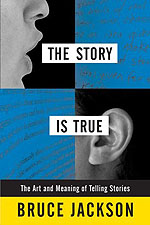Archives
The meaning of stories
Bruce Jackson’s latest book explores the art of storytelling
By KEVIN FRYLING
Reporter Staff Writer
What do the stories families tell each year over holiday meals, the works of William Faulkner and the O.J. Simpson trial have in common?

Each is an effort to organize information into a coherent narrative and find meaning in the jumbled events that comprise our everyday lives, says Bruce Jackson, SUNY Distinguished Professor in the Department of English and Samuel P. Capen Chair of American Culture. His latest book, "The Story Is True: The Art and Meaning of Telling Stories," featuring essays on these topics and more, was published recently by Temple University Press.
"The book explores family stories, political stories, stories in popular imagination, stories in novels and films, stories people use to create themselves and stories people use to explain themselves," says Jackson.
Although some storytellers are professionals, among them novelists, filmmakers and court reporters, he explains that everyone is a storyteller. "There's nobody," he says, "save the youngest of children or the most lunatic, who doesn't make stories." This, he says, is because life is chaotic, and there are few unambiguous beginnings and endings in the real world.
"It's narrative that puts things in their place," he says. "It's narrative that tells us what information fits and what doesn't."
The book pulls together myriad insights from Jackson's prolific career as a scholar interested in the power of stories in people's lives. "I realized that over the years, I had written a number of articles and books dealing with narrative," says Jackson, whose considerable experience in the field includes past positions as president of the American Folklore Society, chair of the board of the American Folklife Center of the Library of Congress and editor of the Journal of American Folklore. "I kept finding new occasions to talk about it."
Jackson recalls that a conversation with his wife, Diane Christian, SUNY Distinguished Teaching Professor in the Department of English, and their former UB English department colleague, Nobel Prize winner J.M. Coetzee, sparked some of his earliest thoughts about the issues tackled in his book. In 1979, Jackson and Christian made a documentary film and wrote a book about men waiting to be executed in Texas. Coetzee asked them how they knew which of the stories told to them by the inmates on Death Row were true.
"I don't think I had put it into words until that moment," Jackson recalls, "but for a long time I had been operating under the principle that the truth of a story is not in what the story tells, but in the fact of the story itself—this story was told by that person, to these people, in this place, in this time. A story came into being or was enacted, and that's a fact as much as the temperature, or what direction the wind was blowing or what you weigh...How it relates to the past is open for discussion. What it's doing is open for discussion. That's what the rest of the book is about."
The meaning of our stories, Jackson notes, changes over time because we change over time. "Our understanding of life changes," he points out. "The fact of death has a different meaning when you're 10 or 30 or 70. You might tell the same story at different times in your life for very different reasons, just as you might read a great novel at different times in your life and find yourself understanding it in very different ways."
These lessons about the protean nature of stories are communicated in Jackson's signature conversational style and packed with examples of stories from popular culture, famous literature and Jackson's own life, which include personal tales, as well as stories gathered from encounters with such well-known individuals as the poet Stephen Spender and actor Peter Fonda.
"I very much see it as having both an academic and general audience," Jackson says of the book. "Part of what I hope people will get out of the book [is] that our stories aren't fixed in stone—they're alive for us."
Up next for the prolific writer, photographer and scholar is a new book project, "Restoring the Eyes: Early Twentieth Century Portraits from a Southern Prison," featuring original text and photo restorations by Jackson of prison mug shots from the Arkansas Penitentiary from 1915-37. Also on the slate are two exhibits of photography by Jackson of Arkansas inmates from the 1970s at the Center for Documentary Studies at Duke University in January and the Old State House Museum of Arkansas History in August 2008.
